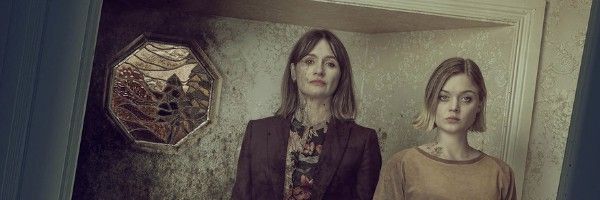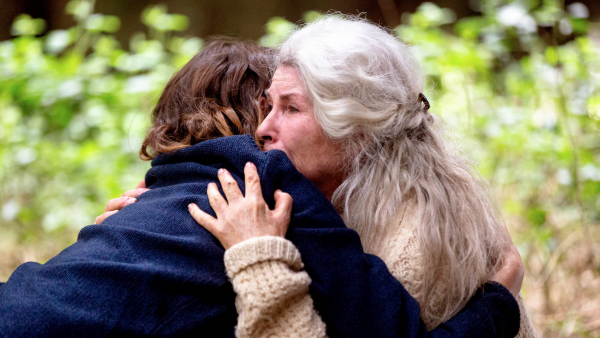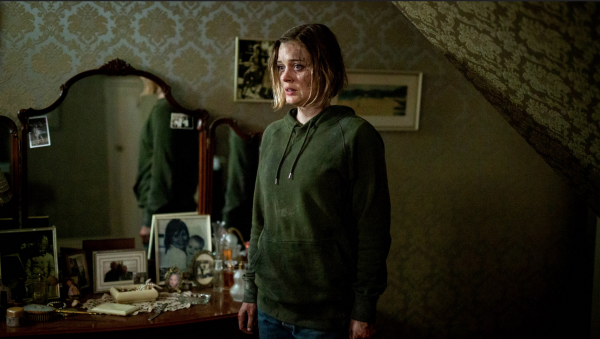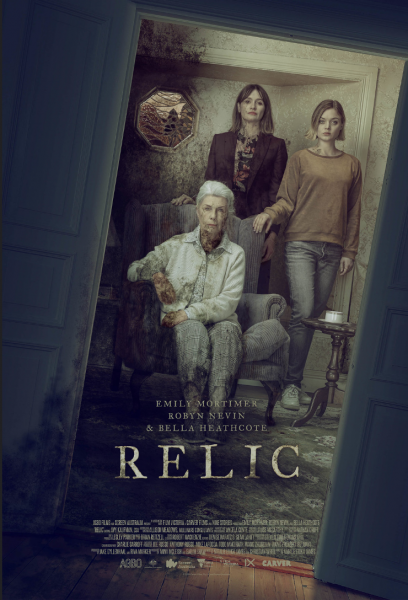Sundance is always an exciting festival for cinephiles. Where lots of fests put the priority on high-profile, star-studded debuts (and Sundance certainly always makes room for a few of those in their schedule,) the Park City film festival has an earned reputation as the launching ground for indie films and up-and-coming talent that haven’t become household names yet. Natalie Erika James is one of those filmmakers making her feature debut at Sundance 2020, with her haunting and deeply personal new horror drama Relic.
The film follows a family thrown in the punishing darkness of confronting of late-life mortality and the threat of a more ambiguous, possibly otherworldly menace when Edna (Robyn Nevin), an octogenarian with signs of dementia, goes missing and turns up a few days later with no memory of where she’s been. Then there are the unexplained markings on her body, an unsettling habit of whispering to herself, and strange personality changes that could be the product of an aging mind or something even more insidious, all of which baffle and terrify her daughter (Emily Mortimer) and grandaughter (Bella Heathcote), who rush back home to help.
For James, the idea for the film sprung from the psychological horrors of her experience dealing with her grandmother’s journey with Alzheimer’s, co-written with Christian White, and seemed a perfect match for the dark genre storytelling she’s always loved.
“It felt like the best kind of medium to tell that story in,” James said over the phone in the lead up to her Sundance debut. “I watched a lot of Asian horror growing up, and I was really into to kind of, as a kid, darker fairy tale, and as I got older, kind of darker, gothic, horror literature. So that was already kind of infused in the way that I tell stories.”
“And I think genre, like horror in particular, is such a great vehicle for social commentary and an amazing genre to talk about fear,” she continued.“I guess in my work, a lot of it is about that. Whether it's Relic's fear of aging, or mortality, or losing your parents, or losing your safety net.”
For James, her filmmaking journey began with what she described as “really pretentious kind of arty films” she started making at 13, which led her to film school, production work, some advertising gigs, and eventually, to Relic. The project started as a proof of concept short that showed off the tone and mood of the film, earning her attention around Australian film festivals and ultimately, signing at WME. And as the feature version came together, it attracted a few high-profile production companies, including Jake Gyllenhaal’s Nine Stories and Joe and Anthony Russo’s AGBO.
“Nine Stories, which is Jake Gyllenhaal's company, they came on board when we were still at script stage, so we actually did a couple of drafts and scripts with them, which is fantastic because we showed it to a few companies, but when we spoke to them about the script, their notes were so aligned with kind of what we wanted the film to be,” James said. “It was a kind of an ongoing creative process with them. Then they were really instrumental in casting, and once they commenced that casting process, AGBO came on board.”
But for James, those new voices and collaborators only helped cement her vision for the film, which pulled from her personal experiences to tap into the universal horrors of aging, mortality, and watching someone you love turn into a stranger. “There's a commonality,” she said, “the fear that everyone faces in such a primal kind of context.”
In Relic, that meant tapping into the elements of genre, including surreal moments of dream imagery. “I think it's a combination of… I was a really big fan of like David Lynch and Lars von Trier in my early kind of filmmaking days,” she said. “They play in a lot of dream-like imagery or lyrical kinds of sequences that evoke of a real mood, or tone, or emotion.”
And though she didn’t realize it while she was making the film, James pulled from a potent which, which worked its way into the imagery of the film’s haunting conclusion. “It wasn't a conscious thing,” she explained, “but now that I think about it, though, definitely kind of just images throughout your life that haunt you or that really resonate with you and are particularly scary that you, yeah, as a storyteller you want to kind of put into your work, because it scared of you, hopefully, it scares other people as well.”
Another crucial horror element was the sound design, which sucks in you into the film’s dreary tone, and which was crafted with a very intentional and precise overlap between the score and the sound design. “I really wanted a distinct kind of soundscape where we didn't rely on anything too orchestral, so that meant that a lot of the music that we use in a lot of sequences is drawing on diegetic sound and sound design, so there was this real big crossover of the design and score elements, even though I did have a composer and a sound design engineer,” James said. “They're both amazing kind of artists in their own right, but then we also kind of cross-contaminate. I mean, some of the sounds that the composer would make the sound designer would use, and then the sound designer's sound, the composer would use in the score, so it was a real kind of, yeah, amazing coming together of those elements.”
And though the six-week shoot was James’ first time directing a feature, it wasn’t her first time seeing the ins and outs of how a director makes a movie – she had the opportunity to shadow Leigh Whannell on the making of his excellent sci-fi/horror Upgrade through a film program in Australia.
“In Australia, we have this program through Film Victoria and Screen Australia as funding bodies where they'll pay you to do a director's attachment, which essentially means that you follow a director around for close to three months, which is exactly what I did with Leigh Whannell,” she recalled. “It was kind of filmmaker's dream to be able to be privy to like every part of that process. And Leigh was really generous with his kind of time and because I'd drive him to set, as well. He certainly was open about sharing just the challenges that he would have on the shoot, and like just advice in general. It's really great because, for example, the set coordinator and the prosthetics artist or the prosthetics lead on Upgrade did Relic, as well. So that was kind of, you know, foster those relationships like a year prior to shooting the film.”
Relic premieres in the Sundance Midnight program on Saturday, January 25. Click here for more of our ongoing coverage from the fest.




